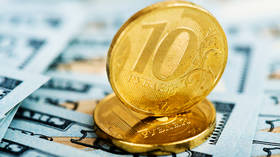
The share of the dollar and euro in settlements has continued to drop, the Bank of Russia says

© Getty Images / Valeriya
The share of the ruble in Russia’s foreign trade operations continues to grow on a monthly basis, data from the Bank of Russia released on Monday showed.
According to the calculations, 39% of payments for Russian export deliveries in May were made in the national currency, along with 30% for imports. The share of “toxic” currencies, the US dollar and euro, has meanwhile declined in exports and imports to 33% and 35% respectively, the regulator said.
Along with the increase in the ruble’s share, the “weight” of the Chinese yuan in Russia’s foreign trade operations has also been on the rise. It reached 25% in exports in May compared to 23% in April, and remained at 31% in imports. In value terms, monthly export revenues in yuan increased from $7.4 billion to $8.4 billion, and from $8 billion to $8.1 billion in import payments.
Russia actively began to replace the dollar and euro in foreign trade last year amid Western sanctions imposed over the conflict with Ukraine. Russia has since dramatically reduced the number of bank accounts and transactions between companies and financial institutions involving Western currencies. Prior to the conflict, the share of the US dollar and euro in Russia’s settlements was around 90%.
READ MORE: China urges increased use of national currencies
The Russian Finance Ministry said last month it expects the share of Western currencies in Russia’s trade to drop further to 10-15% by the end of the year.
According to official figures, as of June, the share of the ruble in settlements between Russia and the countries of the Eurasian Economic Union (EEU) had reached 75%, while over 80% of settlements between Russia and China were made in either rubles or yuan.
For more stories on economy & finance visit RT’s business section



